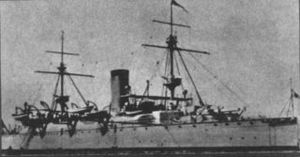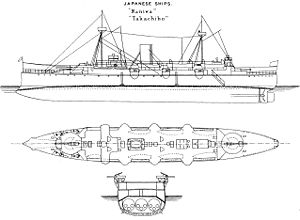- Naniwa class cruiser
-

Japanese cruiser NaniwaClass overview Builders: Armstrong Whitworth, UK Operators:  Imperial Japanese Navy
Imperial Japanese NavyPreceded by: Japanese cruiser Izumi Built: 1884–1885 In commission: 1886–1914 Completed: 2 Lost: 2 General characteristics Type: Protected cruiser Displacement: 3,650 long tons (3,709 t) Length: 91.4 m (299 ft 10 in) Beam: 14 m (45 ft 11 in) Draught: 6.4 m (21 ft 0 in) Propulsion: 2-shaft reciprocating engines; 6 boilers; 7,604 hp (5,670 kW) Speed: 18.5 knots (21.3 mph; 34.3 km/h) Range: 9,000 nmi (17,000 km) at 13 kn (24 km/h) Complement: 357 Armament: • 2 × 260 mm (10 in) guns
• 6 × 150 mm (5.9 in) guns
• 2 × 6-pounder guns
• 10 × quadruple Nordenfelt guns
• 4 × Gatling guns
• 4 × 380 mm (15 in) torpedo tubesArmour: • Deck: 50–75 mm (2–3 in)
• Gun Shields: 37 mm (1.5 in)
• Conning tower: 37 mm (1.5 in)The two Naniwa-class cruisers (浪速型防護巡洋艦 Naniwa-gata bōgojun'yōkan) were protected cruisers operated by the Imperial Japanese Navy. They participated in numerous actions during the First Sino-Japanese War.
Contents
Background
The Naniwa-class cruisers were the first protected cruisers designed in Japan, and built overseas specifically for the Japanese navy. The Japanese naval architect General Sasō Sachū (佐双左仲; 1852–1907) based the design of the Naniwa on that of the earlier Esmeralda-class of the Chilean Navy, which had been acquired by the Japanese navy as the Izumi. He also incorporated elements from the popular Elswick-class protected cruisers, which had been built by the British shipbuilder Armstrong Whitworth for the export market.
The result was a ship with superior specifications; a ship that, when launched, was considered the most advanced and powerful protected cruiser in the world; however, extremely fast development of technology, weaponry and armor in this field of ship design meant that the supremacy of this design was very short.
The Naniwa and Takachiho together cost £546,980. Prince Yamashina Kikumaro attended the launch, and afterwards had dinner with William Armstrong, Ensign (future admiral) Seki Shigetada. Mr J. Hayashi (naval constructor) Lieutenant (future admiral) Miyahara Jiro (senior engineer). Lord Armstrong said that "the ship was destined to the service of a country which was likely never to come into collision with our own peace-loving country". A Major S.T. Bridgford received £4,000 commission on the sale of the two cruisers and was then appointed as the agent for Armstrong in Japan.
Design
The hull of the Naniwa-class cruiser was a typical flush deck with high freeboard to improve seaworthiness. The design still came with a ram attached to the bow.
The 35-caliber 260 mm main guns were mounted in single gun turrets fore and aft. The secondary side-mounted 35-caliber, 152 mm guns were located in semi-circular projections off the main deck.
Propulsion was by two horizontal steam reciprocating engines, 2-shafts, with 6 boilers, yielding a speed of 18 knots (33 km/h) and a range of 9,000 nautical miles (17,000 km) at 13 knots (24 km/h) based on its capacity for 800 tons of coal. Provision was made for four 360 mm torpedoes in above water, deck-mounted launch racks.
Ships in class
Two Naniwa-class cruisers were purchased from Armstrong Whitworth. Both were lost before the start of World War II.
Ordered in 1883, launched 18 March 1885, and completed 1 December 1885, the Naniwa played a major role in the First Sino-Japanese War, notably at the Battle of Pungdo and the Battle of the Yellow Sea. During the Russo-Japanese War it was present at the opening Battle of Chemulpo Bay, but was subsequently assigned a reserve role. After the war, it was lost after running aground on 26 July 1910 on the coast of Urup, in the Kurile Islands.
Ordered in 1883, launched 16 May 1885, and completed 1 December 1885, the Takachiho participated in the Battle of the Yellow Sea in the First Sino-Japanese War. In the Russo-Japanese War it was present at the opening Battle of Chemulpo Bay, but was subsequently assigned a reserve role. In World War I, while covering the invasion of German-held Tsingtao, it was torpedoed by the German torpedo boat S90 on 14 October 1914 and sank with the loss of 271 officers and men.
See also
 Media related to Naniwa class protected cruisers at Wikimedia Commons
Media related to Naniwa class protected cruisers at Wikimedia CommonsReferences
- Evans, David. Kaigun: Strategy, Tactics, and Technology in the Imperial Japanese Navy, 1887-1941. US Naval Institute Press (1979). ISBN 0870211927
- Howarth, Stephen. The Fighting Ships of the Rising Sun: The Drama of the Imperial Japanese Navy, 1895-1945. Atheneum; (1983) ISBN 0689114028
- Jane, Fred T. The Imperial Japanese Navy. Thacker, Spink & Co (1904) ASIN B00085LCZ4
- Jentsura, Hansgeorg. Warships of the Imperial Japanese Navy, 1869-1945. US Naval Institute Press (1976). ISBN 087021893X
- Schencking, J. Charles. Making Waves: Politics, Propaganda, And The Emergence Of The Imperial Japanese Navy, 1868-1922. Stanford University Press (2005). ISBN 0804749779
Naniwa-class cruiserList of ships of the Japanese Navy Categories:- Cruiser classes
- Naniwa class cruisers
Wikimedia Foundation. 2010.

